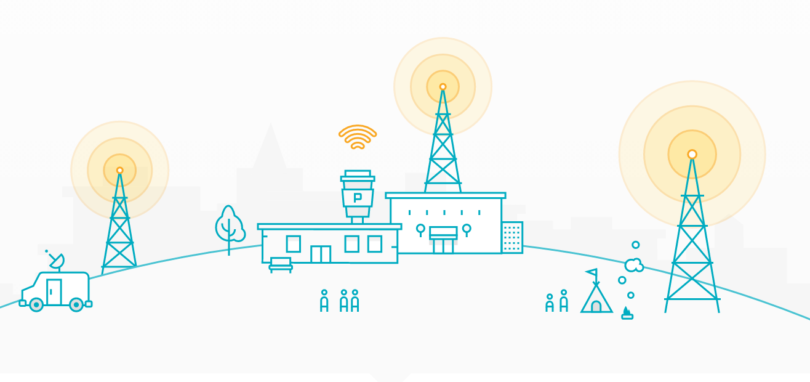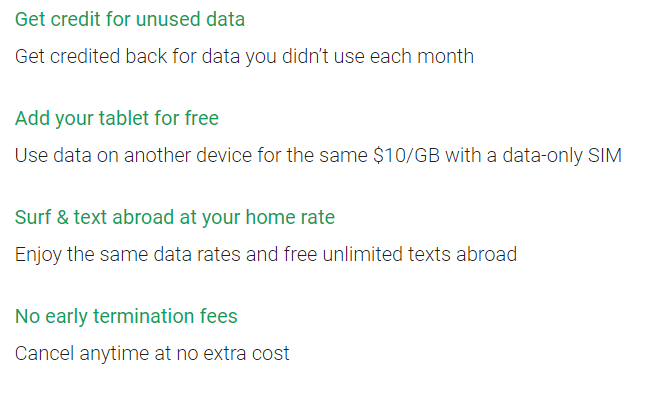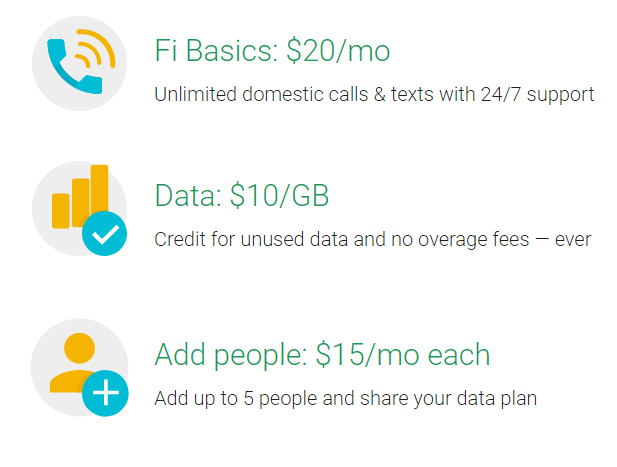A couple of years ago, I signed up for Project Fi during the beta stage. It was new, it was different, it was going to change cell phone service. After moving to Maine, I had to switch because service just wasn’t that good here. After looking back into Project Fi, I decided to give it another shot. If it didn’t work out, I could always hobble back to Big Red, right?
Going Back to Project Fi
Signing Up for Project Fi
When I signed back up for Project Fi a couple of years ago, you had to join a list to receive your invite. At that time, I bought the Motorola Nexus 6, because it was the only Project Fi phone. The camera was really good, but I wasn’t a fan of the size. Now phones with a 6 inch screen aren’t nearly as bulky.
Signing up was very easy. I entered my information into Google and I was sent a new SIM card to put in my phone. Porting my number was quite easy and was completed in a couple of minutes.
The pricing model was something I thought was pretty fantastic as well.
Why Fi?
There are so many cell phone carriers out there, but mainly a few big players. Verizon has always had solid coverage, but their customer service is atrocious. T-Mobile was great, but once I moved to Maine it was non-existent. Sprint…Even with them offering free service for a year, bonus AA miles, and whatever other incentives they offer, I’ve never used them.
One of the big draws to Project Fi, was the fact the phones could switch between CDMA and GSM towers and would utilize Wi-Fi when available.
Project Fi offers a credit on unused data, rather than a use or lose it (or now roll over) data plan.
Project Fi Pricing
I am not a huge data consumer, so Project Fi is pretty ideal for me.
The “Fi Basics” is $20 per month, which gives you unlimited messages and minutes. This does fall in line with access charges for other carriers, but the pricing model shines in the data area.
Project Fi charges $10 per GB of data used. If you use 3 GB, you will be charged $30. If you use 3.5 GB, you will be charged $35. You pay for what you use.
When you sign up , you can choose the data amount you’ll use so you can budget. There is no benefit of choosing 3 GB of data over 1 GB. You are still charged $10 per GB.
When you don’t use your data amount you signed up for, Google will credit your account for the amount you didn’t use. You decided to pay for 2 GB, but only used 1.2 GB? You will receive an $8 credit for your next bill. I think that is pretty fantastic because you actually have a reason to be a data sipper.
If you travel international, you pay the same rate for data. I personally find this better than buying a local SIM (which isn’t a bad option), or paying crazy daily fees for particular companies.
One thing to keep in mind is Project Fi does not trigger the 5x earnings on cards that reward you with bonus points for cell phone services
International Use
One of the big draws to Project Fi was the international coverage. Project Fi offers coverage in 135 countries and territories, which is a large base of destinations.
My first international experience with Project Fi was during my trip to Budapest and Prague. Once we landed in Budapest, Google greeted me to the area and I didn’t have an issue with coverage the entire time.
We took the train from Budapest to Prague and on the train I actually used my phone as a hot spot to write a blog post on the train. Again, there was no issue, except for maybe a 15 minute stretch where it went to 2G speed, but recovered.
In Prague, again we had no issues and the service was fantastic.
Why’d I leave?
When I lived in New Hampshire, the Project Fi coverage was pretty stellar. In addition to that, I was usually in a Wi-Fi area which made it even better. Once I moved to Maine (at the time), there was only T-Mobile and Sprint as part of Project Fi. T-Mobile was only 2G speed and Sprint isn’t worth mentioning.
Verizon is solid in coverage here, and I joined back on our family plan which made sense at the time.
The lack of coverage was too great to actually continue service with Project Fi. If it wasn’t for that, I probably would never have left.
Why did I rejoin?
After rejoining Verizon, I was just going with the flow of daily life and paid only minor attention to Project Fi. I had noticed they added US Cellular to their network, but I hadn’t heard much about them.
I was at work and someone mentioned to me that US Cellular was their carrier and it was 4G LTE coverage in the area. Well, after work I trotted on home and looked and sure enough, Project Fi was MUCH better in this area now.
Add in the fact we have 3 more international trips this year and it made sense to really consider jumping back on the Project Fi train.
It was a pretty easy decision as we travel international a few times per year and I have become more of a data sipper.
Should you Join Project Fi?
This is definitely going to be different for everyone, but I think there are some items to consider.
If you are a data cautious person then I do believe this could absolutely be something to consider. I find it pretty awesome you only pay for the data you use.
Someone who travels internationally, even just a couple of times a year should really consider it. You can even have a data only SIM to use in your tablets or other smart phones, and only pay for the data used. That is a very cheap/affordable way to use your other electronics abroad.
One of the downfalls is the restrictions on the phones used. The phones you’d need to look at are the Pixel, Pixel XL, Pixel 2, Pixel 2 XL, or Motorola X4 Android One. The Motorola is the most affordable of the phones, but the Pixel is definitely a phone worth getting. Even Charlie thinks the Pixel 2 is a top phone for international travel.
If you are considering Project Fi, you can use this link to receive $20 Fi credit after you have been active on Project Fi for 30 days. To be transparent, I would also receive a $20 credit for my bill as well.
The Future of Project Fi
As T-Mobile continues it’s merger with Sprint, I am curious about the future of Project Fi.
My hopes is Project Fi will continue and grow, but there is no telling if T-Mobile will keep the Sprint Towers CDMA, or use them to grow their network as well. If T-Mobile does decide to only use GSM, I think this would deal a blow to Project Fi, but I am not sure to what extent.
I have read some people are upset with Google’s lack of expanding or offering extras. I would actually disagree. Project Fi now has family plans, which you can add people for $15 per line and $10 per GB. The option for data only SIM is still quite strong since only pay for what you use.
They have a solid coverage and their international use is fantastic as well.
Conclusion
I am actually quite happy to be back with Project Fi. The switching of carriers has improved and US Cellular offers great coverage for where I live. The international coverage is solid and I have had great experience with their coverage abroad.
Now my next decision is do I order the Pixel 2, or Pixel 2 XL? 🙂
Do you use Project Fi? Would you even consider it?
Don’t forget to Like me on Facebook, or Follow me on Twitter. If you have questions, comments or would like a topic, leave a comment. Thank you for reading!











Remember, t-mobile ONE offers a similar package but:
1) Unlimited 4G data/texts/voice in US, Canada, Mexico;
2) >140 countries get unlimited free 2G data and texting;
3) voice calls 20c/min abroad elsewhere;
4) One hour free wifi on GoGo inflight. Unlimited GoGo texting;
5) $70 tax inclusive;
6) WiFi calling;
7) Much larger phone choice;
Downsides:
1) data is 2G outside NA;
2) > 50GB/month induces throttling;
On balance this is highly competitive with Google Fi. If t-mobile takes away the 2G overseas speed cap. then the reason to switch away disappears.
T-mobile service is pretty bad outside of major metro areas. I like how Google Fi has multiple carriers enabled.